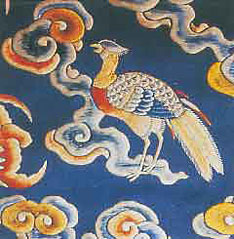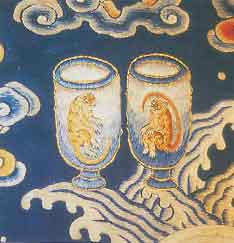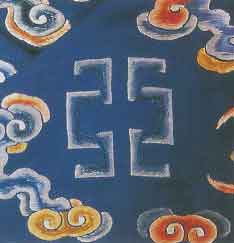

One World
Nations Online
All Countries in the World
 |
 One World Nations Online All Countries in the World |
| Home |
||
___ Twelve Symbols of Sovereignty The Twelve Symbols of Sovereignty (十二章紋) representing Chinese imperial authority appeared on the five-clawed dragon robes (Traditional Chinese: 龍袍 Chinese: 龙袍 lóng páo) of the emperor since the Western Zhou Dynasty (1050-771 B.C.) |
||
|
The Twelve Symbols of Sovereignty are a symbolic interpretation of the universe, these symbols of imperial authority assumed a cosmic significance and represented the emperor as the son of heaven and the ruler of "All under heaven". The symbols (their numbers accumulated over the years) appeared on the sacrificial robes (also called dragon robes) of the emperor: |
||
 The Sun symbolises the source of life. In the context of sovereignty, the Sun is the symbol of enlightenment and is sometimes depicted by the three legged bird (crow) on a red disc. [The three-legged bird is a creature of various mythologies, it inhabits and represents the Sun.] The sun's active principle is Yang. |
||
 A symbol of heaven. The moon is depicted as a light blue or green disc enclosing the legendary hare (Jade Rabbit) pounding the elixir of immortality. [Jade Rabbit or Moon Rabbit according to Chinese beliefs is a companion of the moon goddess Chang'e (嫦娥; pinyin: Cháng'é), constantly pounding the elixir of life.] The moon is representative of the passive principle Yin. |
||
 The Constellation of Three Stars represents possibly Big Dipper and is a symbol of the cosmic universe. The universe, as personified by the emperor, is an unending source of pardon and love. |
||
 The mountain is the symbol of the emperor's ability to rule earth and water, a symbol of stability and of the Earth itself. (Earth one of the five elements.) |
||
 The five-clawed dragon is the emperor's sacred symbol of imperial power, representing its dignity. Even though dragons are mythological animals, they are symbols of the natural world, they are the rulers of the seas and the skies. The rain divinity is associated with heavenly beneficence and fecundity. Dragons symbolise adaptability as they are capable of transformations, they also symbolise power and they are the highest symbol of good luck in the animal kingdom. In Chinese art the dragon evolved from a limbless snake-like creature in the pre Qin dynasty (pre 221 BC) to the composite creature, a combination of many animals, including the horns of a stag, ears of a bull, eyes of a rabbit, claws of a tiger and the scales of a fish, all on a long serpent’s body. |
||
 A symbol of literary refinement. Dragons and Chinese pheasants (kind of phoenix, 凤) represent the animal and bird kingdoms hence the whole natural world. |
||
 A pair of bronze (coloured) sacrificial goblets the symbol of imperial loyalty, it symbolise also the virtue of filial piety (see ancestor worship.) Depicted on the goblets are the two animal kings in the Garden of the Emperor, a tiger or a lion (representing physical strength), and a monkey (cleverness), the tiger as a symbol of the courage to protect and the monkey which stands for intelligence. The goblets represents also one of the five elements (metal). |
||
 One of the five elements, represents purity. and is the noble symbol of the emperor's leadership. (Seaweed represents water, one of the five elements.) |
||
 Grain represents the emperors capacity to feed its people, thus prosperity and fertility, it also symbolises that the emperor is the mainstay for the people. |
||
 Fire is one of the five elements and represents the emperors intellectual brilliance, it also symbolises the summer solstice. (Fire is one of the five elements.) |
||
 The Axe stands for 'cut-off' and represents the emperors power to act decisively. (黼 [fǔ] An axe shaped embroidered pattern of on formal dresses.) |
||
 The bow shaped "fu" sign represents collaboration and the power of the emperor to distinguishing evil from good, right from wrong. (黻 [fú] - an archaic term for an embroidered pattern that is depicted on formal dresses.) |
||
|
Embroidery on a Dragon Robe of the Qing Dynasty Emperor. Images: Nien Museum - Embroidery Museum, Taipei. Earth (mountains); metal (goblets); water (seaweed); wood (grain); and fire (flame) represents the Five Elements. See also: Eight Auspicious Buddhist Symbols Chinese Dynasties History of China Sources: Beijing Municipal Administrative of Cultural Heritage, The Metropolitan Museum of Art, New York, Dictionary: nciku |
||
Country information: China | Bhutan | Hong Kong | India | Japan | Korea | Mongolia | Nepal | Singapore | Taiwan | Tibet | Thailand | Vietnam |
Bookmark/share this page
|
|
One World - Nations Online .:. let's care for this planet To the mind that is still, the whole universe surrenders. 老子 |
| Site Map | Information Sources | Advertise with OWNO | Disclaimer: Privacy Policy, etc. | Contact: [email protected] | Copyright © 1998-2016 :: nationsonline.org |